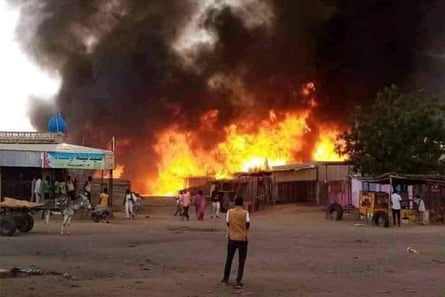How did the current conflict begin?
Fighting broke out in Khartoum, Sudan’s capital, on 15 April 2023 as an escalating power struggle between the two main factions of the military regime finally turned deadly.
On one side are the Sudanese armed forces who remain broadly loyal to Gen Abdel Fattah al-Burhan, the country’s de facto ruler. Against him are the paramilitaries of the Rapid Support Forces (RSF), a collection of militia who follow the former warlord Gen Mohamed Hamdan Dagalo, known as Hemedti.
The RSF was founded by the former dictatorial ruler Omar al-Bashir as an Arab counterinsurgency militia. Bashir wanted to crush a rebellion in the region of Darfur that began more than 20 years ago due to the political and economic marginalisation of the local population.

Initially known as the Janjaweed, the RSF quickly became synonymous with widespread atrocities. In 2013, Bashir transformed the group into a semi-organised paramilitary force and gave their leaders military ranks before deploying them to crush a fresh rebellion in South Darfur.
Hemedti’s current power struggle with Burhan can be traced back to 2019 when the RSF and regular military forces cooperated to oust Bashir from power. When attempts to transition to a democratic civilian-led government faltered, many analysts felt an eventual showdown between Burhan and Hemedti was inevitable.
Why is Darfur at the centre of the conflict?
Home to about 9 million people, Darfur, the vast and largely arid swath of western and south-western Sudan has been at the centre of the ongoing conflict largely because it remains the stronghold of RSF leader Hemedti. Many of the RSF’s recruits are drawn from the region and from Hemedti’s own Rizeigat tribe.
For years, the RSF has terrorised communities in Darfur and much of the region is lawless: militias and other armed groups attack civilians with virtual impunity. Recent evidence indicates that the RSF is involved in ethnic rampages within Darfur against communities such as the Masalits.
In recent years, the RSF has invested significant resources in Darfur in an attempt to control its strategic assets, such as airstrips, mines, water sources and major roads. If the conflict goes badly for Hemedti elsewhere in Sudan – especially in Khartoum and its surrounds – he is likely to withdraw to Darfur. With his force of tens of thousands of battle-hardened fighters, the region would be virtually impregnable.

Analysts trace many of the roots of the latest conflict back to the appalling violence and human rights abuses – possibly genocide – in Darfur about 20 years ago. The UN’s expert on genocide, Alice Wairimu Nderitu, has warned in recent months of “a cycle of violence that finds no end”.
What has been the human cost?
The conflict has plunged Sudan into “one of the worst humanitarian nightmares in recent history”, according to UN officials, who also warn it may trigger the world’s largest hunger crisis. The UN’s children’s agency, Unicef, says that some communities in Sudan have been pushed to the brink of famine.
The conflict in Sudan has also created the world’s worst displacement crisis, scattering more than 8 million people internally and across Sudan’s borders. Nearly 2 million people have fled into neighbouring countries to escape the fighting, putting mounting pressure on Chad and South Sudan.
A lack of funds in South Sudan means 3 million acutely hungry people are receiving no assistance from the UN’s World Food Programme (WFP). Within Chad, a similar dearth of funds means it will have to end support for all 1.2 million refugees inside the country in April.
Officials from WFP warn that throughout the region, nearly 28 million people face acute food insecurity with 18 million in Sudan, 7 million in South Sudan, and nearly 3 million in Chad.

Even before the fighting broke out, the UN estimated more than 3 million women and girls in Sudan were at risk of gender-based violence. Since the conflict, there have been numerous reports of armed forces using rape as a weapon.
The conflict has also robbed huge numbers of an education, with the total number of children in Sudan out of school reaching 19 million.
What is the impact on the wider region?
One of Africa’s largest nations, Sudan lies in a volatile region bordering the Red Sea, the Sahel region and the Horn of Africa. Its strategic location and agricultural wealth have attracted regional power plays, complicating the chances of a successful transition to civilian-led government.
Several of Sudan’s neighbours – including Ethiopia, Chad and South Sudan – have been affected by political upheavals and conflict. Huge numbers of Sudanese refugees have fled the fighting to the country’s neighbours, including hundreds of thousands who have crossed into Chad.

Amplifying tensions are the major geopolitical dimensions at play. Russia, the US, Saudi Arabia, the United Arab Emirates and, most recently, Iran are among the powers battling for influence in Sudan.
The Saudis and the UAE saw Sudan’s attempted transition to a civilian-led government as an opportunity to push back against Islamist influence in the region. They, along with the US and Britain, form the “Quad”, which has sponsored mediation in Sudan along with the UN and the African Union.
Western powers fear the potential for a Russian base on the Red Sea, to which Sudanese military leaders have expressed openness. More recently, Iran appears to have pressed Sudan – unsuccessfully, so far – to let it build a permanent naval base on its coast.
